Lindsay Schmittle
Conservation Leader, ACEER Artist in Residence 2022
Gingerly Press is the printmaking studio practice of letterpress artist, Lindsay Schmittle. Lindsay discovered her love for old-school letterpress printing as a Visual Communications major at the University of Delaware. Jaded by the copious screen time of graphic design, Lindsay found her sweet spot in the letterpress studio, at the intersection of design, illustration and hands-on craft.
After honing her skills at various print shops post-graduation, Lindsay began her own venture under the name of Gingerly Press. She relocated across the state of Pennsylvania to expand her studio practice in Pittsburgh in August 2019.
Inspired by both her big & small adventures in nature, Lindsay creates colorful & playful letterpress printed artworks & stationery products that share nature’s simple stories through vintage handset type and hand-carved blocks. She has collections of letterpress printed wall art inspired by her 2017 solo thru-hike of the Appalachian Trail, her 2022 ACEER Artist Residency working with the Indigenous Maijuna community of the Peruvian Amazon, as well as the most simple of strolls on trails local to Pittsburgh. She creates to share nature’s small beauties, even while on the biggest of adventures, to encourage others to slow down, be mindful, and soak up the simple joys nature has to offer all around us. Her wall art brightens your homes and empowers you to explore the outdoors more, appreciate nature’s beauty, and adopt more sustainable living practices for a healthier planet.
Learn more about Lindsay Schmittle
July 6, 2023
Fighting Habitat Fragmentation with the Lungs of the Earth Landscapes
These torn tropical landscapes are a part of my Lungs of the Earth Collection about my time spent deep in the Peruvian rainforest for an Artist Residency with the Amazon Center for Environmental Education & Research (ACEER) Foundation in January 2022. The ACEER Foundation’s mission is “to design and implement transformative, experiential learning that develops local and global environmental leaders who work to conserve and restore functioning landscapes in the Amazon Basin and beyond.” I was invited as the pilot artist for this new residency program by a past professor who is the current president of the ACEER Foundation.

My artist residency was unlike most typical residencies in that I went with a group of scientists, not fellow artists, and I assisted in field research during most of my days, working alongside the Indigenous Maijuna Community of the Sucusari region of Peru.
My goal with the ACEER residency has been to create colorful artwork that shares the story of the vulnerable biodiverse rainforest and the Indigenous Maijuna community in their fight against a proposed highway corridor threatening their land and livelihood.
For the last year, I have been creating the artwork about my residency experience back in my Pittsburgh print studio. My goal with this residency has been to create colorful artwork that shares the story of the vulnerable biodiverse rainforest and the Indigenous Maijuna community in their fight against a proposed highway corridor threatening their land and livelihood. These Lungs of the Earth Landscapes are the second half of my collection, pairing with the Story-based Abstracts I created in 2022.
A Fight for Survival
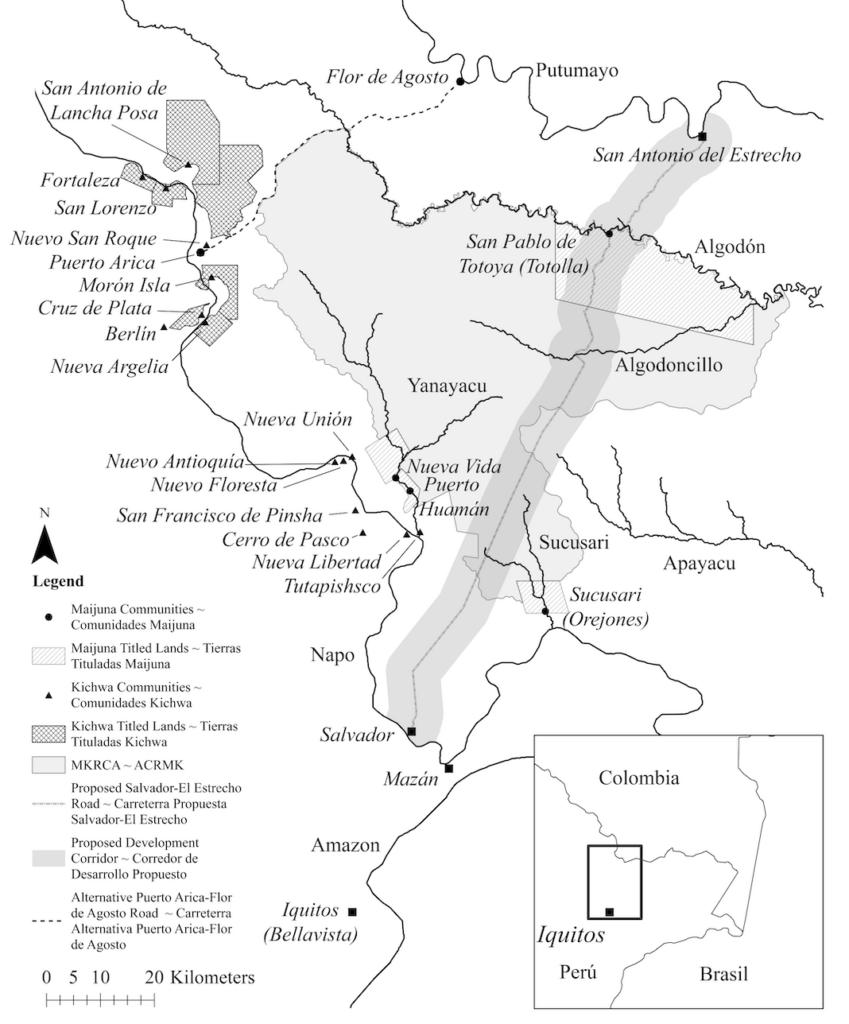
These landscapes share the beauty of the primary rainforest that would be lost from the habitat fragmentation which would occur if the proposed highway corridor were to be built in full, cutting directly through the Maijuna-Kichwa Regional Conservation Area (MKRCA) and titled ancestral lands of the Maijuna. The highway “development corridor” is proposed to be 10 km wide and 130 km long, traveling from the Peruvian city of Iquitos to Colombia. This construction would fragment the forest and open it up to uncontrolled colonization, deforestation and environmental destruction. The MKRCA protects over a million acres of primary rainforest that is a biodiversity hotspot and massive carbon sink vital in the global battle against climate change, and its protection safeguards the cultural identity and physical survival of the vulnerable Indigenous Maijuna who sustainably live off the land.
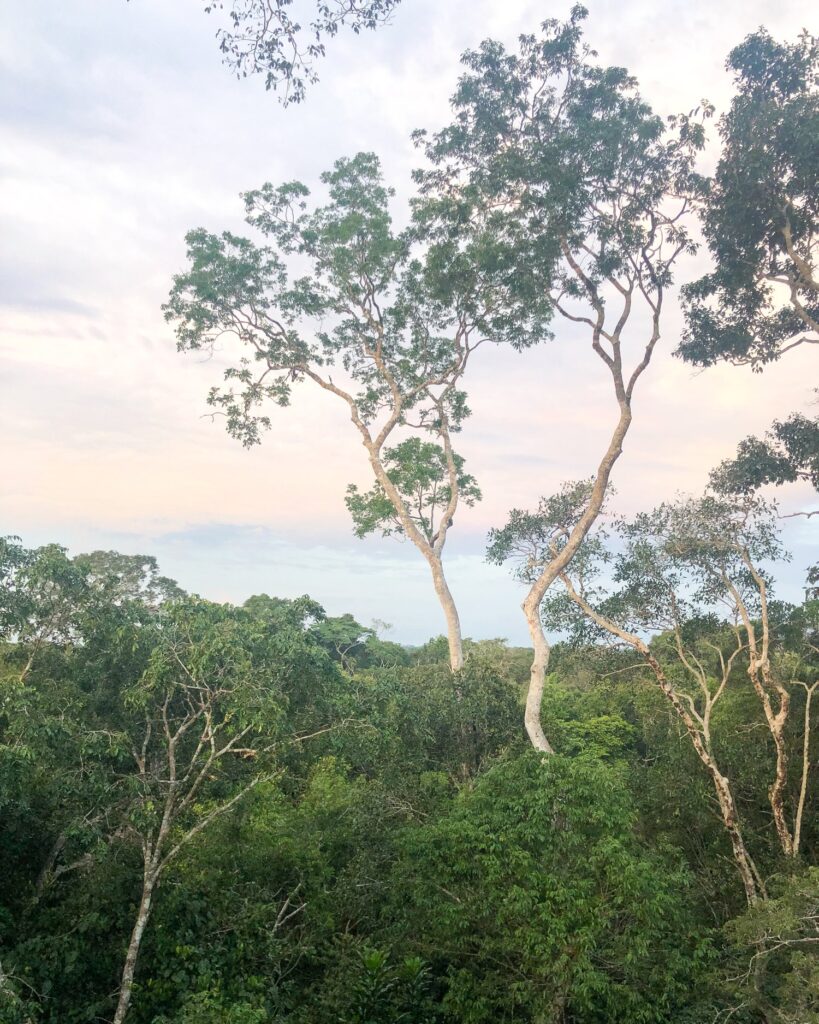
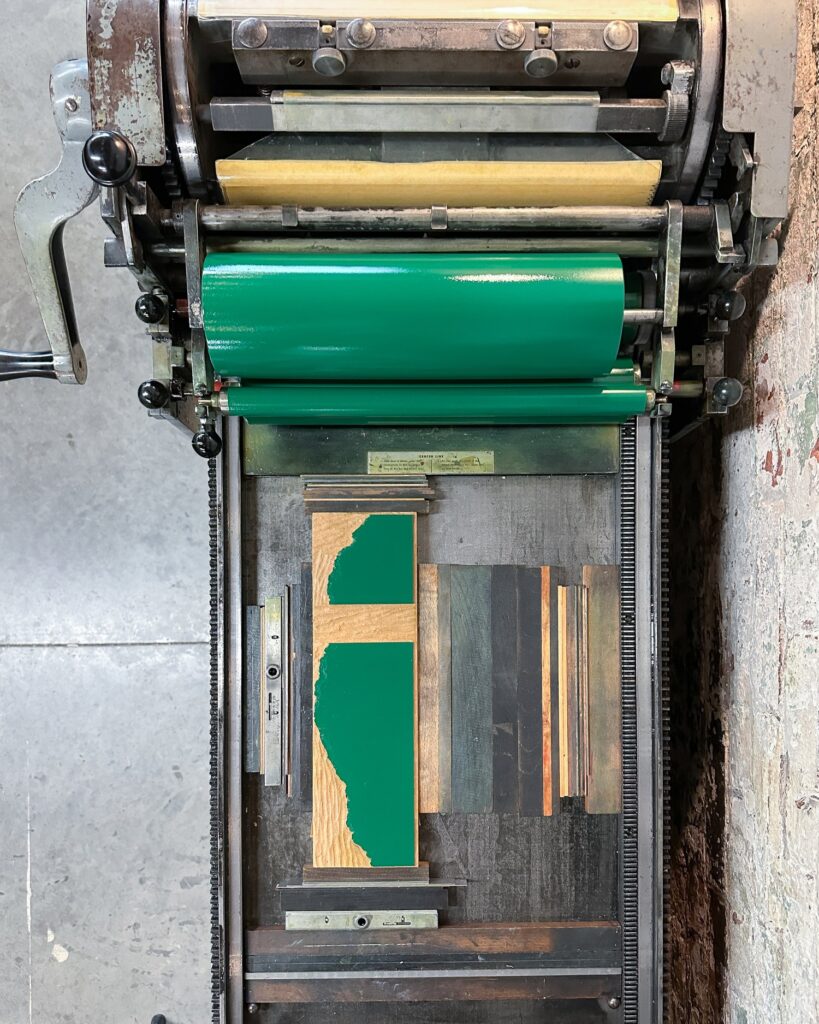
Habitat Fragmentation

I illustrated these landscapes as floating islands with a torn bottom edge to represent the tearing apart of the Earth and ecosystem that a 10 km-wide highway corridor would cause. When habitats are fragmented like this, animal migration paths are severed, creating smaller and smaller isolated islands of native habitat, diminishing the natural resources that support the inhabitants of that area, including the larger mammals of the forest and the Indigenous Peoples who depend on the ecosystem for survival, like the Maijuna.
I illustrated these landscapes as floating islands with a torn bottom edge to represent the tearing apart of the Earth and ecosystem that a 10 km-wide highway corridor would cause.
To create this torn effect for the prints, I tore chipboard to the desired shape, then mounted it on ¾” MDF board, carved down around the edge and spray sealed it so ink doesn’t soak in & deteriorate the printing plate. I then raised this plate up to type high (.918”) with paper to be able to print on my Vandercook press.
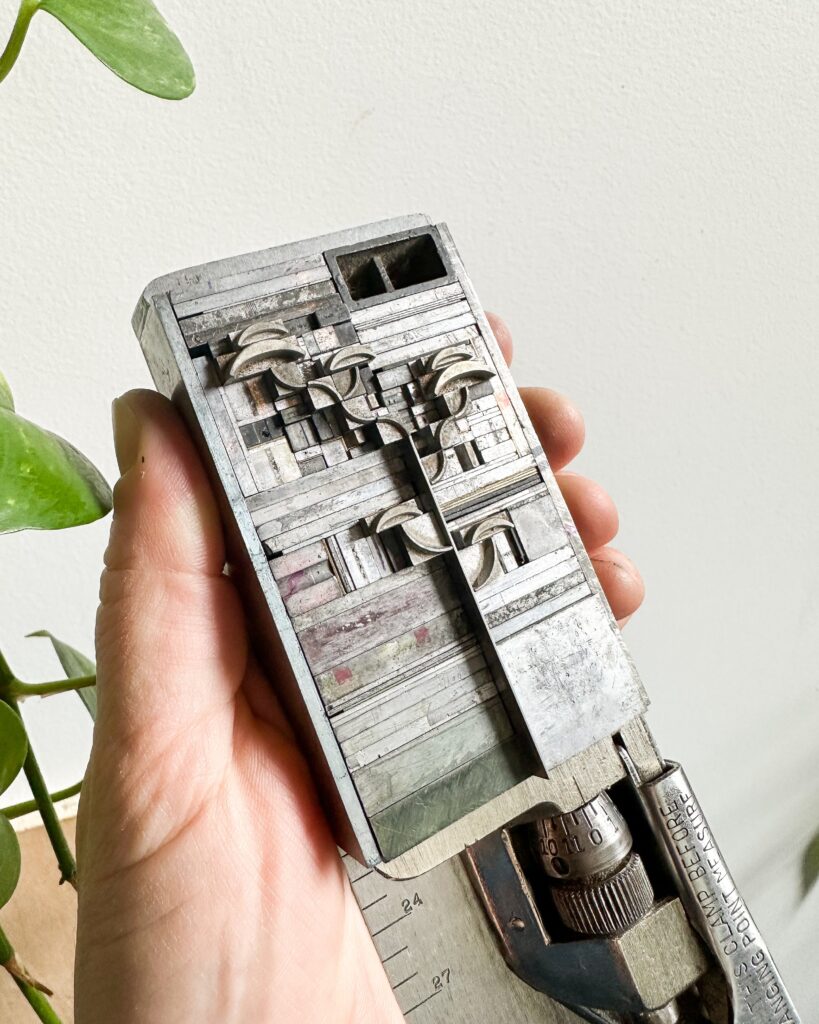

With these landscapes I highlight the natural beauty of this thriving ecosystem that would be lost to habitat fragmentation by illustrating a variety of tropical foliage, birds soaring in the canopy and the Maijuna in canoes on the river. These illustrations are made by handsetting vintage metal ornaments and punctuation. The Maijuna’s canoe is an ornate vintage bracket turned on its side. The canopies of the squiggly trees are bold parenthesis stacked on their sides and the leaves of the understory palm-like-foliage are a lighter weight of parenthesis turned on angles. The line that sits in the canoe representing the Maijuna is a 10point Bernhard Gothic Heavy capital “I”, and vintage metal ornaments make up the soaring birds in the canopy.
I included the Maijuna boating in canoes in many of these landscapes because the Maijuna are a sustainable part of this natural ecosystem under threat. The Maijuna have lived off the land, fishing, hunting and foraging in this region since time immemorial. However, the construction of this highway corridor threatens their cultural identity and physical survival, as they will be forced to enter the modernized workforce to raise funds to buy food at local markets or they will starve if their sustainable hunting grounds are destroyed and their rivers polluted by development.
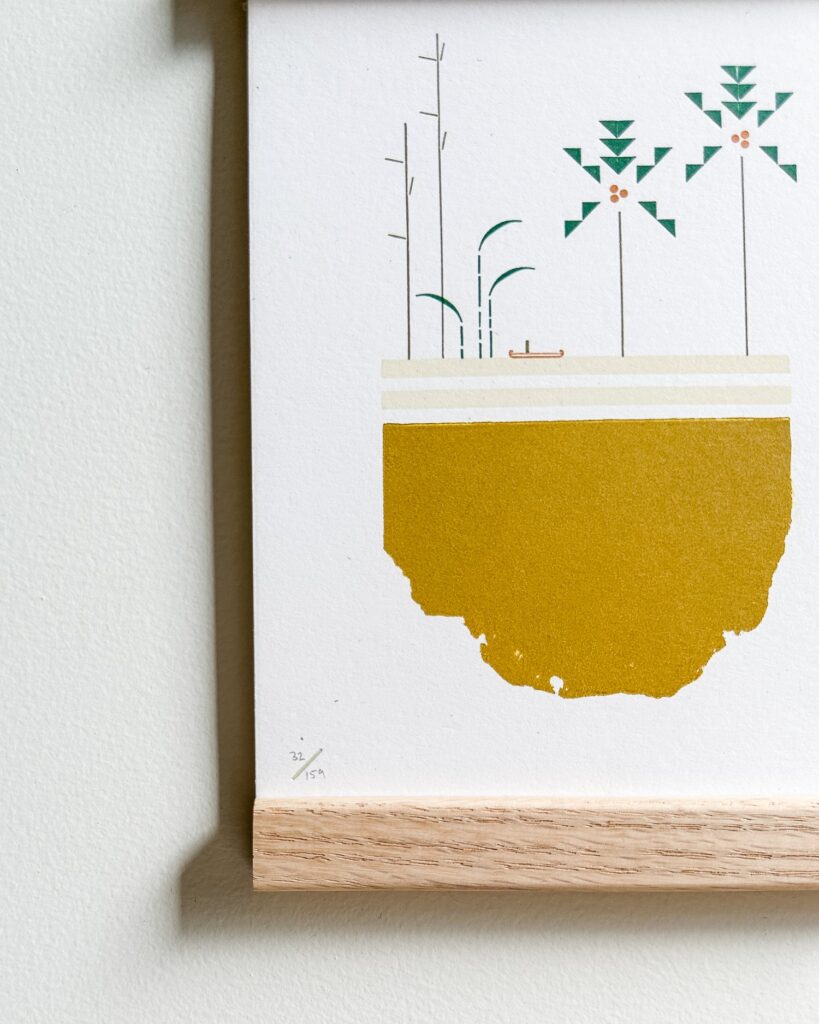

I included the Maijuna boating in canoes in many of these landscapes because the Maijuna are a sustainable part of this natural ecosystem under threat.
Illustrating Various Ecosystems of the Forest
The Aguajal
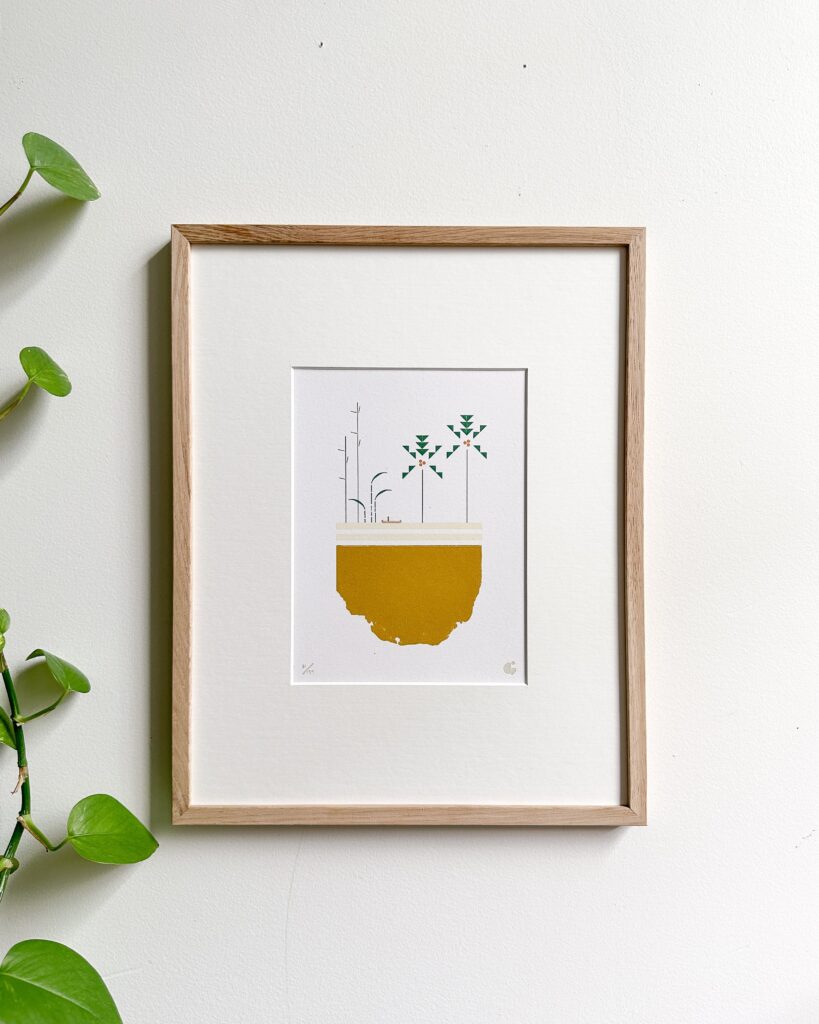
The palm-filled wetland swamps in the Amazon Rainforest inspired this particular torn landscape print. In Peru, these wetland swamps are referred to as an “Aguajal,” named after the Aguaje Palm (Mauritia flexuosa) that grows right out of the swampy waters.
There was an Aguajal nearby to where our group of researchers stayed, and I’d enjoy walking around it to discover many new-to-me chirping birds and insects. The best song was from the Oropendula bird that would make this distinctive call sounding like a water droplet—it was so loud at the Aguajal because of all the Oropendula calls! I highly recommend listening to some Oropendula audio for your own enjoyment!
The Collpa
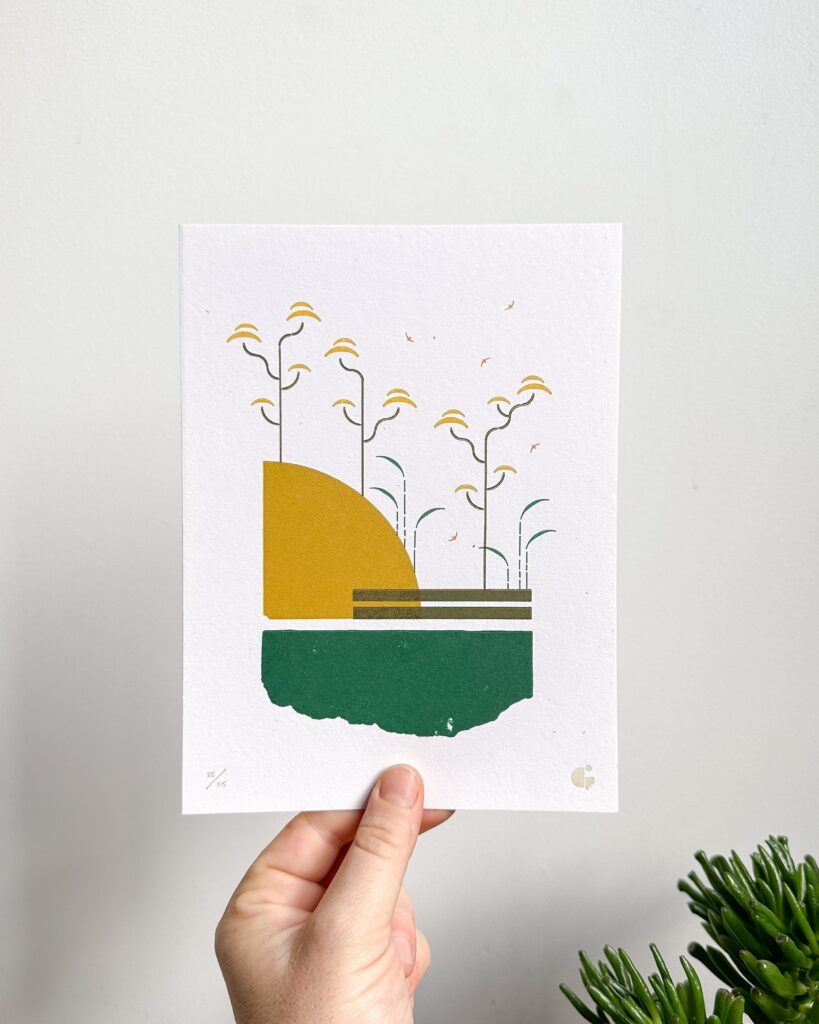
Our field research involved trekking miles through the rainforest brush, following Maijuna hunters who cleared a path and led the way with a machete. The hunters were leading us to some of their hunting spots: mineral licks where large animals in the rainforest gather.
Mineral licks, called “Collpas” in the local Spanish dialect, are swampy forest habitats often at the base of a hillside where a “face” of clay-like mineral-rich soil is exposed. The animals, from large tapir and peccary to sloths, monkeys and parrots, gather to lick this face of mineral-rich soil to supplement their diets, and the Maijuna sustainably hunt some of these larger animal visitors in order to feed their families. The collpas are an essential part of the sustainable rainforest ecosystem.
The scientists and I were led to the collpas to collect soil samples & set camera traps to show proof of the existence of these larger animals and that these collpas are culturally & economically important to the survival of the Maijuna. If the proposed highway construction continues, many of these essential collpas will be destroyed, causing a chain effect of malnourishment throughout the region.
The Headwaters

This particular landscape represents the headwaters up the Sucusari River where we traveled with the Maijuna hunters to conduct additional research. It took us 6 hours via boat to get up river to the headwaters, as the river got more and more narrow while we traveled deeper into the primary forest. Plants & trees hung over the river, creating a skinny tunnel for traveling and we often had to lay down in our boats to glide under the hanging foliage. This truly felt like the wild jungle that one thinks of when envisioning the Amazon, so densely biodiverse, with life dangling off every surface. These are sacred lands, and they are threatened to have the proposed highway corridor cut directly across them, cutting through the headwaters of the Sucusari, poisoning the rest of the river downstream that feeds the forest and the Maijuna.
The Lungs of the Earth
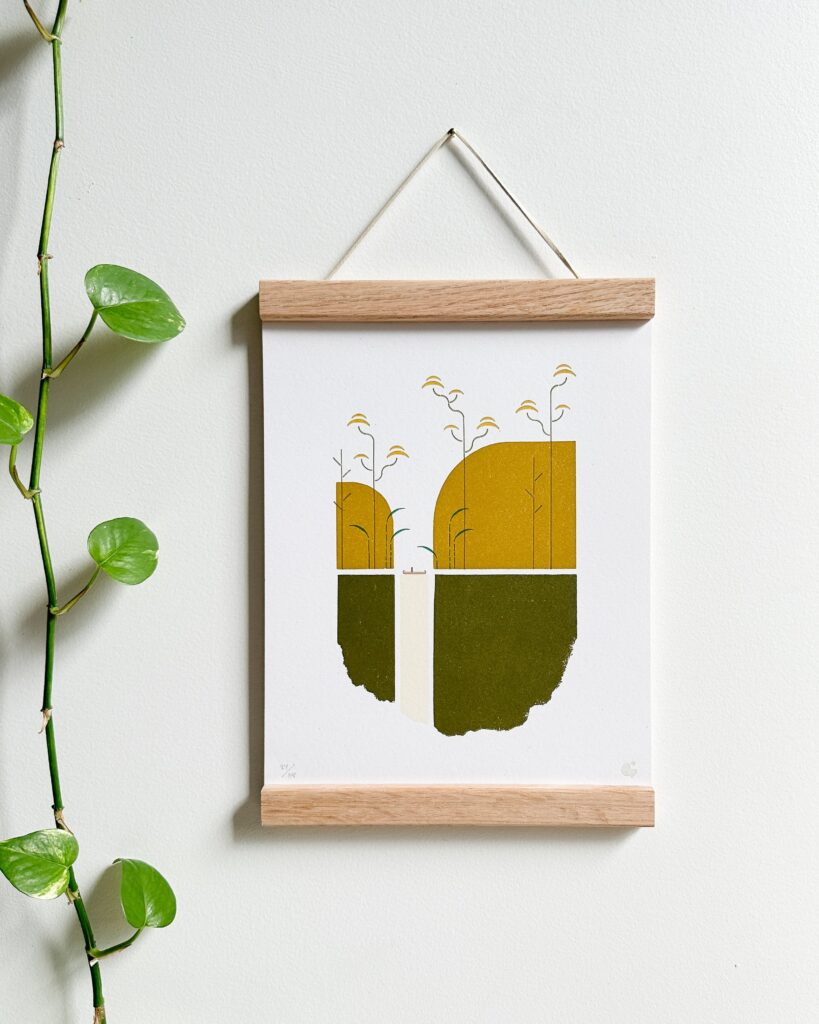
Within this 14×18” headliner landscape piece for the collection, titled Lungs Of The Earth, I used my last piece of the palm leaf sheath from the Huacrapona palm (Iriartea deltoidea) that I had collected off the forest floor while in the rainforest. I mounted this sheath to a MDF block to capture its texture as a printing plate. I used the texture of this palm sheath to represent the fresh oxygen and mist that rises from the dense forest as the trees clean the air and store climate warming CO2 in their fibers. The Amazon Rainforest is known as the Lungs of the Earth and one the the largest global carbon sinks for these air filtering abilities within its dense tree-filled forest. This piece illustrates the importance of the Amazon on a global scale and therefore the importance of protecting it from habitat fragmentation and destruction.
Giving back to the Maijuna & Rainforest
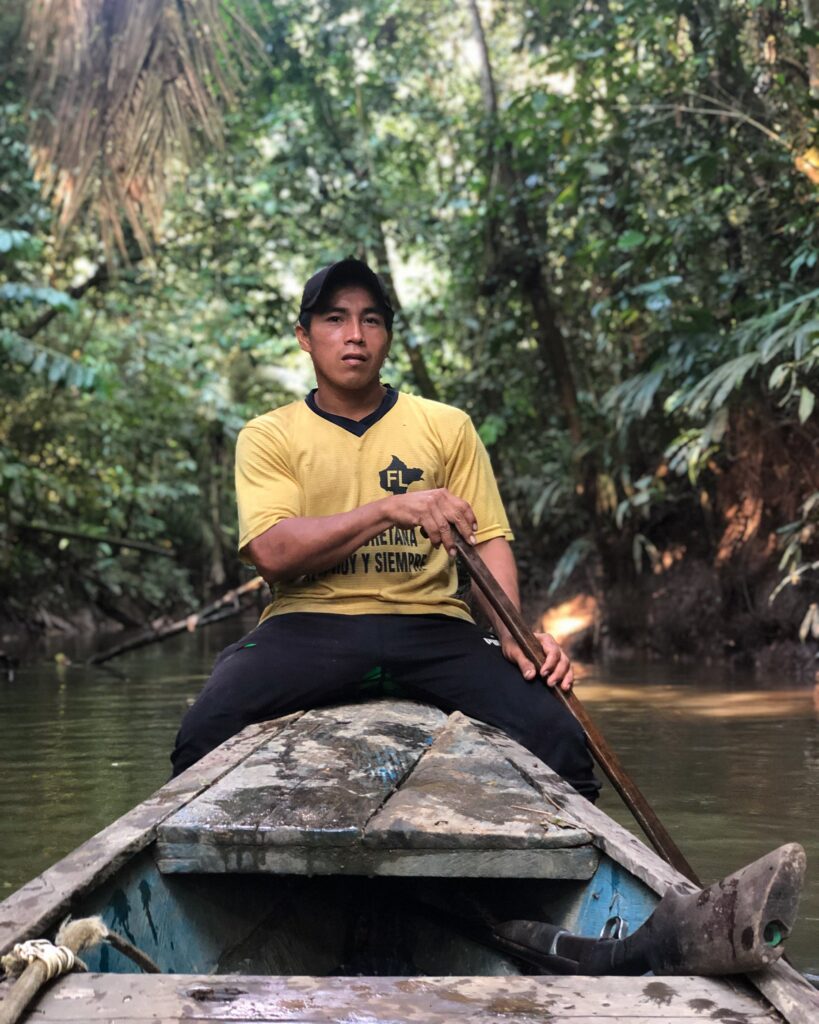
A portion of proceeds of every print sold will be donated to the ACEER Foundation and designated for the fight against the proposed highway corridor threatening the survival of the Maijuna Indigenous Community. If you would like to help the Maijuna, the rainforest, and help fight climate change, please also consider watching the documentary and signing the petition linked below.
Returning to the Amazon

I am so excited to have been invited back to the Sucusari region of the Peruvian Amazon this July 2023 as a trekking leader for this continued research on the relationship of mineral licks in the region with the Indigenous Maijuna community and the animals of the rainforest. We will be trekking deeper in the forest this time to deploy more camera traps in order to track these sustainable mammal relationships with mineral licks and therefore work to prove the importance of protecting this massive conservation area and Maijuna Ancestral Title Lands from the proposed highway corridor.
While this trip is technically not another artist residency, you can expect that I will be soaking up inspiration around every turn on these daily rainforest treks for my 20 days abroad. I’m not making any guarantees for a whole new collection of artwork about this summer’s trip, but I know for sure that at least the Q3 print for my Hot Off The Press Subscription will be inspired by this trip!
I will have limited wifi access while in the forest, so Instagram is the best place to follow along on this next wild journey!
